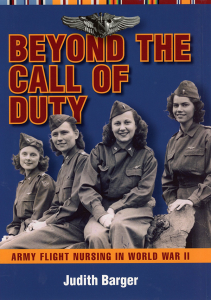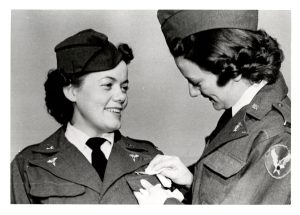First in a Series of Ten Blogs offering A Short History of Nursing from antiquity through the mid-twentieth century. Part 1 – From Sacred to Secular – covers nursing in ancient
times through the Crimean War. Part 2 – From Civilian to Military – continues with
the establishment of the Saint Thomas School of Nursing through World War II.
A Short History of Nursing
Through World War II
Part 1 From Sacred to Secular Nurses
Wet Nursing in Ancient Times
“The nurse is the mirror in which is reflected the position of women through the ages,” writes Victor Robinson, who sums up the prevailing view of nursing held as late as the mid-twentieth century that nursing care came naturally to women from Mother Nature and required no special predilection or training. The distinction between the untrained and trained nurse “is a sharp commentary on the follies and prejudices of mankind.” 1 Nurses have encountered these follies and prejudices against their presence when engaged in nursing outside the home repeatedly throughout history as they sought professional recognition for work vital to the health of their nation, in peace and in war.
Little is known about nurses and nursing care prior to the birth of Christianity, though the Old Testament mentions nurses, among them Deborah, nurse to Rebekah who married Abraham’s son Isaac; most references are to midwives or wet nurses. Ancient civilizations did not have individuals designated as nurses to tend the sick and injured; that care apparently fell to household servants and slaves. Nursing was considered a specialized function only in the cases of the midwife and of the wet nurse brought into the home to suckle infants whose mothers either could not or would not breastfeed their own babies.
Wet nursing has been a controversial topic since the beginning of recorded history. Although the earliest wet nurses may have been slaves who had no choice in the matter, the fact remained that some mothers were placing their newborn infants at the breasts of other women to suckle by choice, not always for legitimate medical reasons, instead of fulfilling their maternal duties. The practice often was one of convenience for the mother, not necessarily for the baby. While classical Greek and Roman authors address wet nursing as common in their societies, moralists expressed their dislike of the mercenary practice; the philosopher Favorinus, for instance, thought it “unnatural, imperfect, and half-motherhood” to give one’s child to another for suckling. 2
Contemporary physicians preferred that the mother breastfeed her own infant but acknowledged that wet nurses still would be needed in certain cases and thus advocated their careful selection. 3 From her study of the wet nurse in ancient medicine and Greek papyri, Amal Abou Aly lists the desirable characteristics of the ideal wet nurse as “prudent, clean, tidy, not ill-tempered, sympathetic, merry, easy going, gentle and self-controlled in relation to drinking and sexuality.” 4 Physicians addressed the suitable age for wet nurses and the importance of a good diet to produce healthy milk as well. 5 Even in the first two centuries, writings reflect a belief that the infant assumed the wet nurse’s disposition through proximity and that diseases might be transferred from nurse to infant: “Shall we then allow this child of ours to be infected with some dangerous contagion and to draw a spirit into its mind and body from a body and mind of the worst character?” Favorinus asked. 6 Documents indicate that wet nurses were regulated and monitored, at least in theory if not in practice, regarding illness, diet, and quality of milk. 7
Selection of a wet nurse was still an issue in the sixteenth century because of the belief brought forward over time that a child took on the nature of the nurse through her breast milk. Writing in 1531, English scholar and diplomat Sir Thomas Elyot spelled out the nurse’s qualifications: she should be no younger than twenty or older than thirty, with a body clean from sickness and deformity, and a pure, sanguine complexion in order to produce sweet, substantial milk. 8 Robert Burton reinforced the importance of choosing a wet nurse wisely in 1651 when he wrote that the first ill accident that could befall a newborn infant was a bad nurse. 9
Joseph Vogt’s research on slavery in ancient Greek and Roman society focuses on the relationship of nurses, tutors, and physicians with their masters as babies, children, and patients. 10 He identifies Euryclea as the first in a long line of enslaved wet nurses and touches on the contested issue of entrusting one’s newborn infant to the care of another woman. Writing of their tenderness, Vogt credits nurses and nannies with a person’s happy childhood and cites evidence that a “spiritual bond” developed between the slave and her charge that could last throughout life. “It was on the basis of this real-life experience that nurses and nannies were made the foster-mothers of their charges and the confidantes of their mistresses in drama, and particularly in classical Greek tragedy.” 11 He supports this claim with Aeschylus’s Choephori in which Orestes’s nurse mourns his death, showing her love for and loyalty to the man whom she once suckled as an infant.
Vogt, Virginia Hunter, and Kelly Wrenhaven note evidence of the affection for nurses in ancient Greek art and epitaphs. As Vogt states: “Whatever literature may have had to say about the old woman who was dirty, drunk and talkative, these inscriptions show such a warm regard on the part of so many people … that we can be in no doubt as to which was the voice of real life.” 12 Hunter confirms the special relationship between nurses and their charges throughout life, noting that given the amount of time spent together, “Intimacy, confidence, and trust must often have developed” between women and slaves. 13 “The nurse who held a position of trust and confidence in her charge’s or her former charge’s house is not unique,” Hunter surmises, offering plays of Menander, Aeschylus, Sophocles, and Euripides as support. 14
Yet Sandra Joshel is wary of speculation based on available evidence: “The social distance and power relations between nurse and nursling give the intimate relations at the center of nursing a contradictory quality. At least, we would expect that the feelings of nurse and nursling might differ and that their views would involve contradiction and ambivalence.” 15 Writing about the subjectivity of wet nurses as slaves in ancient Roman culture, Joshel adds a caveat: Accepting the adult nursling’s perspective of his or her wet nurse in absence of the nurse’s own perspective can give a lop-sided view of the relationship. 16 The single-minded loving kindness attributed to the good nurse does not give the full picture of the nurse who may harbor the same resentment or resistance felt by other slaves. “The good nurse is an ambiguous figure,” Joshel explains. “Either she is to be acted upon, to be treated as if she were a tool under the control of its owner, or she becomes a subjective being who acts, feels, and thinks.” 17 Descriptions of the good nurse in literature should be viewed in this context.
Keith Bradley, whose research focuses on the social status of wet nurse and nursling in ancient Rome, has identified epitaphs in which nurses’ names appear. Like Joshel, he questions whether these inscriptions by the nurse to her nursling are accurate indicators of the relationship between nurse and child, because only sixty-nine epitaphs are available for study. Bradley concludes: “It is clear not least from the nutrix inscriptions that the relationship between nurse and nursling was sometimes close and warm, enduring at times far beyond the nursling’s early years.” 18 Literature supports this view, with the nurse “the symbolic comforter figure, telling stories to her nursling, rocking the cradle and singing the child to sleep,” lending a romantic view to the situation. Yet, as Bradley points out,
In terms of sheer probability negative or neutral relationships are likely to have been as common as the positive ones attested. But nurses who had no concern for their nurslings and nurslings who had no affection for their nurses have left no commemorative evidence of their attitudes, and so it cannot be simply assumed that the nurse’s relationship with a child was always warm and loving. 19
He stresses that whatever the sentiment between nurse and nursling, wet nurses were an exploited commodity: as slave or even as mercenary the wet nurse had little choice in the matter of which infant she nursed. Bradley explains: “Above all her availability as a nurse depended on her subject, inferior status and her manipulation by a superior party: that element of manipulation and the constraints upon freedom it brought cannot be glossed over by the superimposition of a veneer of historical romanticism.” 20 Bradley’s research has special relevance to opera’s former wet nurses such as Die Amme in Richard Strauss’s Die Frau ohne Schatten (1919 Vienna) , whose relationship with her nursling the Empress is ambiguous, with shows of affection offset by questionable methods of demonstrating that sentiment.
Not all nurses of ancient Greece were slaves, Mark Golden states. Although some Athenian women may have kept a slave as wet nurse whom they sold after their child was weaned around age two, others hired fellow citizens as wet nurses. Golden notes that “Both nurses and paidagōgoi [pedagogues or tutors] were special as well as specialized because they occupied positions of extraordinary trust.” 21 As an example, he cites Pantheia, who gives last instructions to her nurse before committing suicide after her husband has died:
“Nurse, when I am dead, cover us with the same cloak.” And the nurse entreated and besought her, but she could not move her, and when she saw that she did but vex her mistress, she sat down and wept in silence. Then Pantheia took the scimitar, that had been ready for her so long, and drew it across her throat, and dropped her head upon her husband’s breast and died. And the nurse cried bitterly, but she covered the two with one cloak as her mistress had bidden her. 22
To learn how the history of nursing was reflected on the opera stage, see Judith Barger, The Nurse in History and Opera: From Servant to Sister (Lexington Books, 2024).
Notes
- Victor Robinson, White Caps: The Story of Nursing (Philadelphia: Lippincott, 1946), vii, 1.
- Aulus Gellius, The Attic Nights of Aulus Gellius, trans. John C. Rolfe, vol. 2 (London: Heinemann, 1927), Book 12, Section 1, 355.
- Plutarch, Plutarch’s Moralia, vol. 1, trans. Frank Cole Babbitt (Cambridge, MA: Harvard University Press, 1969), section 5.
- Amal Abou Aly, “The Wet Nurse: A Study in Ancient Medicine and Greek Papyri,” Versalius 2 (2) (1996): 88.
- Ibid.
- Gellius, Attic Nights, 359.
- Aly, “The Wet Nurse,” 88.
- Donald W. Rude, ed., A Critical Edition of Sir Thomas Elyot’s The Boke named the Governour (New York: Garland, 1992), Book 1, Section 4, 34.
- Robert Burton, The Anatomy of Melancholy [1621], ed. Floyd Dell and Paul Jordan-Smith (New York: Tudor, 1927), 282–84; Gellius, Attic Nights, 357, 359.
- Joseph Vogt, Ancient Slavery and the Ideal of Man, trans. Thomas Wiedemann (Cambridge, MA: Harvard University Press, 1975), 105.
- Ibid., 107, 108.
- Ibid., 108–109; Virginia J. Hunter, Policing Athens: Social Control in the Attic Lawsuits, 420–320 B.C. (Princeton, NJ: Princeton University Press, 1994), 86; Kelly Wrenhaven, “A Comedy of Errors: The Comic Slave in Greek Art,” in Slaves and Slavery in Ancient Greek Comic Drama, ed. Ben Akgrigg and Rob Tordoff (Cambridge: Cambridge University Press, 2013), 140.
- Hunter, Policing Athens, 86.
- Ibid.
- Sandra R. Joshel, “Nurturing the Master’s Child: Slavery and the Roman Child-Nurse,” Signs: Journal of Women in Culture and Society 12 (1) (Autumn 1986): 19–20.
- 1 Ibid., 21.
- Ibid., 8.
- Keith R. Bradley, “Wet-Nursing at Rome: A Study in Social Relations,” in The Family in Ancient Rome: New Perspectives, ed. Beryl Rawson, (Ithaca, NY: Cornell University Press, 1986), 220–21.
- Ibid., 221.
- Ibid., 222.
- Mark Golden, “The Effects of Slavery on Citizen Households and Children: Aeschylus, Aristophanes and Athens,” Historical Reflections / Réflexions Historiques, 15 (3) (1988): 457.
- Xenophon, Cryopaedia [eBook 2085], ed. F. M. Stawell, trans. Henry Graham Dakyns (Urbana, IL: Project Gutenberg, 2009), 7.14.3.
Featured Image:
nick-van-den-berg-GVheioPZdpk-unsplash copy.jpg



